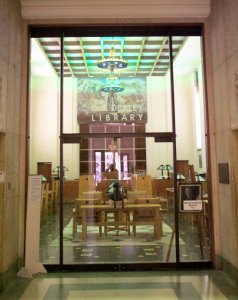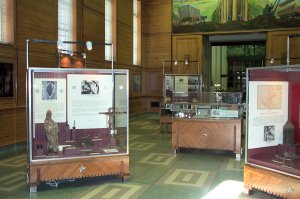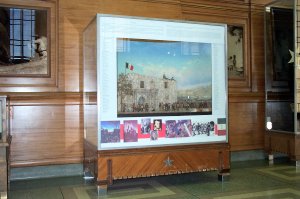|
|
Return to: Texas Hall of State Intro
East Texas and West Texas Rooms
|
|
|
The East Texas Room is used to display some of the more interesting historical artifacts in the Dallas Historical Society collection. It is paneled with wood from East Texas dark gum trees. Here are two murals created by Dallas artist Olin Travis. They depict East Texas before and after the great "oil boom" of the early 20th-century. The "before" picture, over the doors leading to the West Texas Room, shows a tall stand of pine trees which are being sawed down and loaded by crane on to a flatbed rail car. Also depicted is an old mule-drawn cotton wagon, loaded down and headed for the cotton gin just down the road. Barely discernible, lying in the rich soil can be seen "sleeping giants" which represent as yet undiscovered oil.
In the second mural, at the opposite end of the room, the "sleeping giants" have awakened and seen rising up out of the ground and into a thick dark cloud in the center of the painting. Beams of light extend from their open palms, shining on to refineries and oil derricks on either side. The skyscrapers of modern cities rise up behind the refineries. A truck and train are also seen here as well as a strange-looking oil pump called a "spider."
During the 1987-89 renovations to the Hall of State, the West Texas Room (see photo below) was transformed into the George B. Dealey Library, for use by researchers wishing to have access to the Dallas Historical Society's extensive collection. Glass doors now separate it from the East Texas room. Presently, it is open by appointment only.

Just inside the doors, on a tabletop, rests a bronze bust of David Crockett that was donated to the Dallas Historical Society on August 17, 1986 by the artist, William "Bill" Easley. On that same date, at a ceremony in the Hall of State attended by hundreds of visitors celebrating the 200th anniversary of Crockett's birth, the author of this web site was given the honor of unveiling the bust, which rests on piece of stone from the same quarry that supplied the building materials for the Alamo.
The murals in the room were painted by native-Texas artist Tom Lea of El Paso. The one on the far wall depicts a cowboy, lariat in hand, standing in the center of the painting with two other cowboys riding horses behind him on the mural's left. One of the horses pictured here belonged to the artist's father and the other had been ridden by Lea himself. On the viewer's right is a herd of Hereford cattle, with a windmill, water tank, and corral in the background, along with some West Texas mountains.
Tom Lea used his brother and his sister-in-law as models for the man and woman shown riding in a wagon in the other mural. Also pictured is a young boy by their side. All three seem to be leaning in response to the wagon's progress along a rough trail and in the background is the rugged scenery of West Texas.
This room has other decoration worth noting. There are hand-hewn wooden beams on the ceiling and the far wall, below Lea's mural, is covered with cowhide (hair and all!). In front of it, on a stand, is a carved wooden figure of a cowboy by Dallas artist Dorothy Austin. The other walls are covered with a thick plaster that resembles adobe. On it are impressed numerous cattle-brands and colorful tiles on the wall depict Indians, pioneers, cowboys and other West Texas types.
Principal Information Sources:
- The author's own training and experience as a volunteer tour guide at the Hall of State, 1985-1990.
- A Gathering of Symbols: Texas History in the Hall of State (Dallas: Dallas Historical Society and the Junior League of Dallas, Inc., 1985).
Copyright © 1996-2012 by Steven Butler, Ph.D. All rights reserved.








